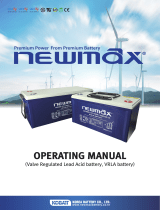
5
Ah counting can be used to control the recharge (i.e.103%
of discharged Ah is returned/115% in terms of Wh returned)
using a device with accuracy ±1% of the expected current
range. However, inaccuracies associated with equipment
calibration and/ or controller algorithm accuracy can lead to
drift in determining the true state of charge (SoC), meaning
that periodic equalisation charge and recalibration of SoC is
required.
Where Current Absorption Rate or Ah counting is used to
control the recharge, the battery voltage can be maintained
at a constant of 2.35Vpc to 2.40Vpc provided that the battery
temperature is controlled at or below +50°C.
Where the voltage cannot be adjusted to values >2.40Vpc to
compensate for temperatures below 20°C, the time to full state
of charge will increase.
The voltage/temperature compensation is +3mV/°C/Cell for a
temperature lower than 20°C (77°F) (the reference temperature
being 20°C) and -3mV/°C/Cell for a temperature higher than
20°C.
6. Service Life
Under normal operating conditions, the battery lifetime largely
depends on the temperature and depths of discharge. The
service life in cycling applications is based on the number of
years with a daily depth of discharge and can never exceed
the design life of 12 years at 20°C.
See Number. of Cycles vs DoD graph, Figure 2, and an
example of a SuperSafe® SBS® XC battery at 25°C:
Daily Depth
of Discharge
(%DoD)
Number of Cycles
at 25ºC
Estimated Life
Expectancy
(Years)
30 3,600 9.8
7. Maintenance
SuperSafe SBS XC monoblocs and cells are VRLA batteries
and do not have to be topped up with water.
• Do not open the valve. Opening could cause lasting
damage to the battery and is prohibited.
• The containers and lids should be kept dry and free from
dust. Cleaning must be undertaken with a damped cotton
cloth without additives and without man-made bres or
addition of cleaning agents, never use abrasives or solvents.
• Do NOT use any type of oil, solvent, detergent, petroleum
based solvent or ammonia solution to clean the battery
containers or lids.
• Discharge any possible static electricity from clothes by
touching an earth connected part.
8. Data Recording
It is recommended that, as a minimum, the following
information is recorded by means of regular data logging,
which the user must make available to EnerSys® to validate any
warranty claim.
1) Records of the commission charge.
2) The number of cycles performed and the depth of discharge
(DoD) of each cycle.
3) The duration of each charge and discharge cycle, and the
Ah in and Ah out, or Wh in and Wh out.
4) Full details of the recharge voltage/current prole for the last
50 cycles.
5) A full history of the ambient and battery surface
temperatures, recorded at regular intervals throughout
battery operation and life.
6) The time and date of each event. An event is dened as
the start/stop of the battery discharge, the start/stop of the
battery recharge, the start/stop of any input power source.
9. Disposal
SuperSafe SBS XC products are recyclable. End of life
batteries must be packaged and transported according to
prevailing transportation rules and regulations. End of life
batteries must be disposed of in compliance with local and
national laws by a licensed battery recycler.








